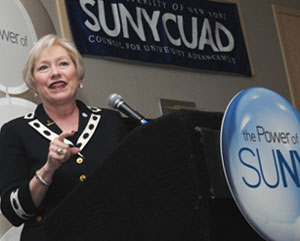SUNY Chancellor Calls for a More Competitive SUNY to Lead the State’s Economic Recovery
Outlines SUNY’s Capacity to Create & Retain 40,000 Jobs in New York Over Next 5 Years
Will Implement Performance-Based Resource Allocation & Streamline Operations with Shared Services
 SUNY Chancellor Nancy L. Zimpher |
ALBANY, N.Y. – Jan. 19, 2010 – Chancellor Nancy L. Zimpher, in delivering her first “State of the University” address, promised to lead the State University of New York’s vast 64-campus system into a new era of transparency and accountability while outlining policies that will help create and retain approximately 40,000 jobs in New York. Chancellor Zimpher also unveiled plans to implement performance-based resource allocations at 29 state-operated campuses and to streamline backroom operations through shared services for a more cost-effective and efficient system.
In order to maintain the academic excellence that is SUNY’s core mission, the Chancellor outlined a strategic enrollment management system to deliver academic programs in the most cost-effective and student-centered manner, including the expansion of online course offerings to speed time to graduation.
“We pledge to deliver a more competitive SUNY to the State of New York. We will be transparent and accountable as we work to fulfill our fullest potential by educating the most adept workforce in the nation, improving the business climate in our state and enhancing the quality of life for all New Yorkers,” said Chancellor Zimpher. “SUNY - with 64 campuses that stretch across the state - is the most qualified public institution to navigate the knowledge economy and re-imagine the role of public higher education in our state’s economic development.”
“Clearly, public higher education stands at a crossroads,” the Chancellor continued. “Diminishing public investment, new demands on our resources, and rapidly shifting economic sands require that we be increasingly agile and adaptable. At the same time, these very changes have only added to SUNY’s importance to the welfare of our state and its residents. Moreover, our history, our mission, and our relationships with the communities we serve make us equal to the task.”
New York’s current financial problems make it impossible for the State to provide financial support at the level required to maintain SUNY as a quality institution that graduates students who are prepared to take on and succeed in the 21st-century knowledge economy. This same financial environment makes it unfair to expect tuition-paying students to make up for all that the State cannot afford to fund. To answer these challenges, Chancellor Zimpher outlined three critical steps to help close the gap between State support and a competitive SUNY:
- Create partnerships with the private sector to undertake projects that both advance SUNY’s mission of teaching, research and service and create jobs where they are most needed. SUNY has already put in place a process for identifying and vetting opportunities for partnering with the private sector that assures the project’s financial viability protects organized labor interests and that promotes SUNY’s core mission and values. It is conservatively estimated that SUNY can produce approximately 20,000 new jobs through these and other partnerships over the next five years. Separately, SUNY estimates that it will create another 20,000 construction jobs.
- Implement a fair and equitable tuition policy that has a five-year planning window for students and their parents, and an assurance that tuition will feed the campuses' ability to provide courses and programs that speed time to graduation for our students.
- Partner with the Governor and Comptroller to cut red tape surrounding procurement of goods and services.
Additional reforms will be implemented through the Chancellor’s office, in conjunction with the SUNY Board of Trustees and campus presidents, to help make a more competitive SUNY. These reforms will focus on making the SUNY system more efficient in order to focus resources to provide excellence in education for students. The reforms include:
- Implement performance-based resource allocation – Beginning with the fiscal year 2012, SUNY will distribute state support among its state-operated campuses based on performance in critical areas. The Chancellor’s office will work with campus presidents to determine these areas and define the allocation formula, but they may include research expenditures and awards, student course completion, retention and degree completion, and/or degree programs that address workforce shortages and the needs of emerging industries.
- Streamline operations through shared services – SUNY must address the inefficiencies associated with 64 campuses replicating 64 sets of activities by consolidating backroom operations and administrative infrastructure as well as eliminating unsustainable financial models. However, this will be done without compromising student access.
Through the development of a strategic enrollment management system, SUNY will achieve premier status among the world’s great universities. SUNY has the capacity to grow excellence in teaching and learning; to enhance its commitment to research, inquiry and innovation; and to extend its service to the betterment of New York. To achieve these goals, SUNY will:
- Guarantee transfer for students from one SUNY school to another.
- Cut by half gaps in college attendance and graduation for low-income and minority students by 2015.
- Coordinate online offerings to ensure core requirements for popular majors are available each semester.
- Track global activities taking place across the university enterprise through a new software partnership with our new SUNY Global Center in New York City.
- Re-examine program growth and delivery to meet the State’s needs, develop critical skills, and keep pace with tomorrow’s technology.
“There is a clear connection between a competitive SUNY and a competitive New York,” said Chancellor Zimpher. “This is the essence of The Power of SUNY, our strategic roadmap for the decade ahead. The power of education is to transform our society, our economy and our future. Our fates are truly interconnected and reciprocal. It could be said, as SUNY goes, so goes New York; as New York goes, so goes SUNY.”
About the State University of New York
The State University of New York is the largest comprehensive university system in the United States, educating more than 467,000 students in more than 7,500 degree and certificate programs on 64 campuses with more than 2.5 million alumni around the globe. To learn more about how SUNY creates opportunity, visit www.suny.edu



